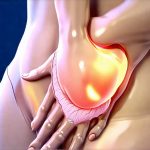Urinary tract infections (UTIs) are incredibly common, affecting millions of people each year, with women being disproportionately impacted. While many associate UTI symptoms with burning during urination and frequent urges to go, a less discussed but equally distressing experience is the intensification of pain after sitting for extended periods. This phenomenon can be particularly baffling – why would simply resting seemingly exacerbate discomfort? It’s not that sitting causes the infection itself; rather, it interacts with existing inflammation and pressure points in ways that amplify perceived pain signals, making what might have been a manageable ache transform into something significantly more intense and disruptive. Understanding this connection is key to both managing symptoms effectively and recognizing when further medical evaluation is needed.
The discomfort isn’t merely about the physical sensation; it’s often intertwined with anxiety and frustration. Many individuals find themselves altering their daily routines, avoiding work or social engagements, because of fear of prolonged sitting and the subsequent pain flare-ups. This can lead to a cycle of worry and hyper-awareness, where even anticipating sitting triggers heightened sensitivity. It’s crucial to remember that this increased discomfort is often a natural consequence of the infection and postural factors rather than a sign of worsening illness – though it always warrants attention and appropriate management strategies. Recognizing these complexities helps in navigating both the physical and emotional challenges associated with UTIs. If you’re wondering why urinary pain can intensify, it’s helpful to understand contributing factors.
The Role of Pressure and Inflammation
The bladder, urethra, and surrounding pelvic structures are sensitive areas. When an infection is present, inflammation significantly increases this sensitivity. Sitting puts direct pressure on the pelvic floor muscles, the lower abdomen, and consequently, the bladder itself. – This compression can irritate the already inflamed tissues, triggering or intensifying pain signals. Think of it like pressing on a bruise; even gentle pressure can be quite painful. The longer you sit, the more sustained the pressure becomes, leading to prolonged discomfort.
The effect is further compounded by how we typically sit. Slouching, for example, restricts blood flow to the pelvic region and puts uneven stress on different areas of the lower back and pelvis. This impaired circulation can hinder the body’s natural healing processes and exacerbate inflammation. Conversely, maintaining good posture – sitting upright with proper lumbar support – can help distribute pressure more evenly and potentially lessen discomfort. It’s important to note that this isn’t a cure for a UTI, but a way to mitigate some of the aggravating factors.
Furthermore, the nerves in the pelvic region are closely intertwined. Inflammation from a UTI doesn’t stay localized; it can radiate outwards, affecting nearby nerve endings and contributing to referred pain – meaning pain felt in areas other than the original site of inflammation. Sitting then becomes a catalyst for this broader neurological response. This explains why some people experience lower back pain or even thigh discomfort alongside their UTI symptoms, especially after prolonged sitting. It’s important to know why you might still feel UTI symptoms even after treatment.
Understanding Pelvic Floor Dysfunction
Pelvic floor dysfunction (PFD) is a common condition that often co-exists with UTIs and can significantly contribute to the increased pain experienced while and after sitting. The pelvic floor muscles support vital organs like the bladder, uterus (in women), and rectum. When these muscles become tight, weak, or uncoordinated – due to factors such as chronic straining, pregnancy, childbirth, or even stress – it can lead to a variety of problems, including urinary frequency, urgency, incontinence, and pain.
- A UTI exacerbates PFD because the inflammation further irritates already sensitive pelvic floor muscles. Sitting compresses these muscles, potentially triggering muscle spasms and increased pain perception. This creates a vicious cycle: infection leads to inflammation, which worsens PFD, which intensifies pain with sitting, leading to more stress and potential for further dysfunction.
- Identifying and addressing PFD alongside UTI treatment can be crucial for long-term relief. Techniques like pelvic floor physical therapy (PFPT) – involving exercises designed to strengthen or relax the pelvic floor muscles – are often highly effective. A qualified PFPT therapist can assess your specific condition and create a personalized treatment plan. In some cases, lingering discomfort may lead you to wonder why you might feel like you have a UTI even after antibiotics.
The Impact of Posture & Ergonomics
Good posture isn’t just about aesthetics; it’s fundamental to minimizing pressure on the bladder and surrounding structures. When sitting, aim for: – Maintaining a neutral spine (avoiding slouching or excessive arching). – Using lumbar support to fill the natural curve of your lower back. – Keeping your feet flat on the floor or supported by a footrest. – Taking frequent breaks to stand up and move around.
Ergonomic considerations extend beyond just your chair. Your workstation setup plays a significant role. A poorly positioned monitor can force you to strain, leading to muscle tension that radiates down to the pelvic region. Similarly, reaching for a mouse or keyboard can put undue stress on your back and hips. – Adjusting your workspace to ensure everything is within easy reach minimizes these strains. Consider using a standing desk option for part of the day to reduce prolonged sitting altogether.
The Role of Hydration & Bladder Habits
While often overlooked, adequate hydration and mindful bladder habits can play a significant role in managing UTI symptoms and reducing pain, especially related to sitting. Dehydration concentrates urine, making it more irritating to the inflamed bladder lining. – Aiming for consistent fluid intake throughout the day (water is best) helps dilute your urine and flush out bacteria. However, avoid excessive fluid before bedtime, which can lead to nighttime awakenings and exacerbate discomfort.
Furthermore, ‘holding’ your urine frequently irritates the bladder and weakens its muscles over time. This can contribute to pelvic floor dysfunction and increase sensitivity. – Establish regular bathroom breaks throughout the day, even if you don’t feel a strong urge, to prevent prolonged bladder fullness. Avoiding excessive caffeine and alcohol can also help reduce bladder irritation as these act as diuretics. These simple lifestyle adjustments, combined with appropriate medical treatment, are essential for managing UTI pain effectively. It’s important to remember is pain after peeing always a sign of infection?
It is important to note that this information should not be considered medical advice, and you should always consult with a healthcare professional if you suspect you have a UTI or are experiencing related symptoms. They can provide an accurate diagnosis and recommend the most appropriate course of treatment.





















